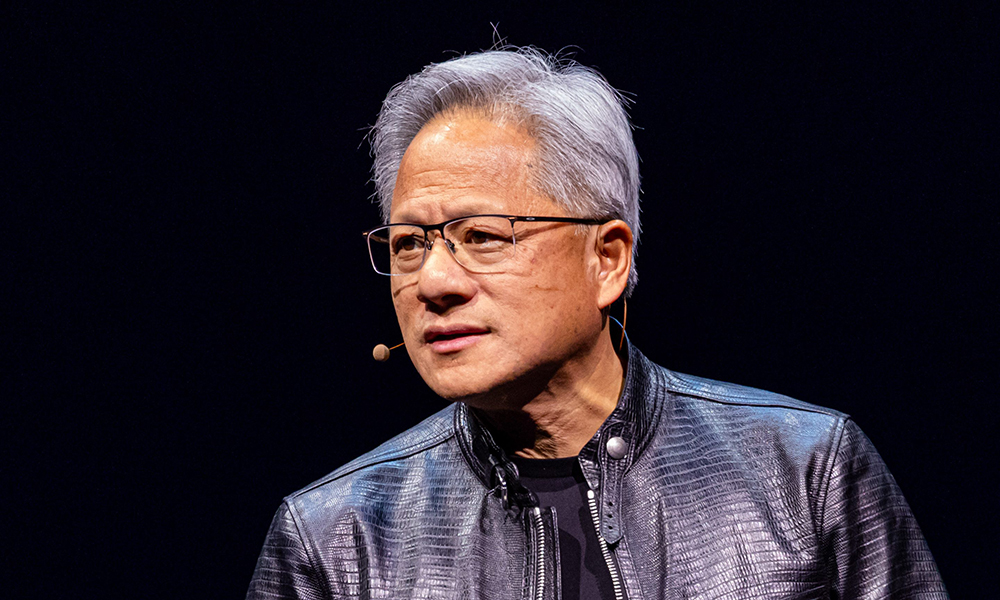
英伟达CEO黄仁勋声称,英伟达的人工智能芯片业务是多样化的,但公司的申报文件却显示,几家大客户为其贡献了近一半营收。图片来源:ANNABELLE CHIH—BLOOMBERG/GETTY IMAGES
微芯片设计公司英伟达(Nvidia)第二季度的营收翻了一番以上,这主要得益于几家大客户的贡献。公司接近一半的销售额来自这几家公司。
四家大客户直接采购的商品和服务,合计占英伟达300亿美元营业额的46%。出于竞争原因,对四家客户的身份进行匿名处理。在英伟达公布备受期待的季度投资者报告时提交的10-Q监管申报文件显示,四家客户贡献的营业额约为138亿美元。
每家公司的采购额占公司总营收的十分之一以上,而且它们所采购的产品,都与英伟达蓬勃发展的数据中心芯片业务有关。在人工智能淘金热中,埃隆·马斯克等企业家都在争相建设数据中心。
全面来看,这四家客户所贡献的销售额,超过了英伟达上一年度公布的全年销售额。
虽然这四家神秘的人工智能巨头的名字不得而知,但它们可能就在亚马逊(Amazon)、Meta、微软(Microsoft)、Alphabet、OpenAI或特斯拉(Tesla)当中。
英伟达最热门的产品是人工智能芯片,例如H200。OpenAI的GPT-4等大语言模型需要使用这些芯片进行训练。这些芯片还被用于驱动推论过程,即ChatGPT或Sora等根据文本提示生成答案的过程。
英伟达对少数几家大客户的依赖,也引发了市场对于其单一业务突然的、指数级增长能否持久的担忧。艾略特管理公司(Elliott Management)和城堡投资公司(Citadel)等投资者,也对这种增长能持续多长时间存在质疑。
历史证明这种担忧是有道理的。半导体行业的繁荣和衰落周期是众所周知的。
有一家客户为英伟达带来的收入,超过了英伟达第二大业务的营收
事实上,英伟达的业务与这些大客户之间的关系非常重要,以至于公司在季度报告中有一个章节的名称就是“营收集中”,专门分析了这种集群风险。
英伟达在其10-Q监管申报文件中表示:“我们经历了大量营收来自少数客户的阶段,而且这种趋势可能会持续下去。”
这种趋势能带来惊人的利润。今年上半年,英伟达每10美元营收中,就有5.60美元是净收入——这是大多数公司求而不得的毛利润率。
这也解释了为什么今年上半年英伟达的税后利润比去年同期增长了近四倍,达到315亿美元。英伟达的营收和利润能否继续以如此迅猛的速度增长,对于公司的投资至关重要。
以申报文件中提到的“客户B”为例:其直接采购额占英伟达300亿美元营收的11%。这意味着仅仅这一家公司为英伟达一项业务贡献的收入,就超过了其第二大业务游戏业务的总营收(29亿美元)。
但在整个上半年,客户B贡献的营收比例始终低于10%,这意味着它在上个季度似乎突然增加了支出。“客户C”也是同样的情况;英伟达提供的数据完全相同。
英伟达CEO黄仁勋在上周三接受彭博电视台采访时回答了一个问题:除了微软、谷歌和亚马逊等行业巨头以外,其需求还来自哪些方面?
他表示:“目前我们的客户已经相对多元化。”他列举了一批不同的客户群体。
但英伟达公布的数据似乎反驳了这个结论。例如,在去年同期,无论是第一季度还是第二季度,英伟达没有任何一家直接客户的业务,占总营收的比例达到或超过10%。
英伟达并未立即回复《财富》杂志的置评请求。(财富中文网)
译者:刘进龙
审校:汪皓
微芯片设计公司英伟达(Nvidia)第二季度的营收翻了一番以上,这主要得益于几家大客户的贡献。公司接近一半的销售额来自这几家公司。
四家大客户直接采购的商品和服务,合计占英伟达300亿美元营业额的46%。出于竞争原因,对四家客户的身份进行匿名处理。在英伟达公布备受期待的季度投资者报告时提交的10-Q监管申报文件显示,四家客户贡献的营业额约为138亿美元。
每家公司的采购额占公司总营收的十分之一以上,而且它们所采购的产品,都与英伟达蓬勃发展的数据中心芯片业务有关。在人工智能淘金热中,埃隆·马斯克等企业家都在争相建设数据中心。
全面来看,这四家客户所贡献的销售额,超过了英伟达上一年度公布的全年销售额。
虽然这四家神秘的人工智能巨头的名字不得而知,但它们可能就在亚马逊(Amazon)、Meta、微软(Microsoft)、Alphabet、OpenAI或特斯拉(Tesla)当中。
英伟达最热门的产品是人工智能芯片,例如H200。OpenAI的GPT-4等大语言模型需要使用这些芯片进行训练。这些芯片还被用于驱动推论过程,即ChatGPT或Sora等根据文本提示生成答案的过程。
英伟达对少数几家大客户的依赖,也引发了市场对于其单一业务突然的、指数级增长能否持久的担忧。艾略特管理公司(Elliott Management)和城堡投资公司(Citadel)等投资者,也对这种增长能持续多长时间存在质疑。
历史证明这种担忧是有道理的。半导体行业的繁荣和衰落周期是众所周知的。
有一家客户为英伟达带来的收入,超过了英伟达第二大业务的营收
事实上,英伟达的业务与这些大客户之间的关系非常重要,以至于公司在季度报告中有一个章节的名称就是“营收集中”,专门分析了这种集群风险。
英伟达在其10-Q监管申报文件中表示:“我们经历了大量营收来自少数客户的阶段,而且这种趋势可能会持续下去。”
这种趋势能带来惊人的利润。今年上半年,英伟达每10美元营收中,就有5.60美元是净收入——这是大多数公司求而不得的毛利润率。
这也解释了为什么今年上半年英伟达的税后利润比去年同期增长了近四倍,达到315亿美元。英伟达的营收和利润能否继续以如此迅猛的速度增长,对于公司的投资至关重要。
以申报文件中提到的“客户B”为例:其直接采购额占英伟达300亿美元营收的11%。这意味着仅仅这一家公司为英伟达一项业务贡献的收入,就超过了其第二大业务游戏业务的总营收(29亿美元)。
但在整个上半年,客户B贡献的营收比例始终低于10%,这意味着它在上个季度似乎突然增加了支出。“客户C”也是同样的情况;英伟达提供的数据完全相同。
英伟达CEO黄仁勋在上周三接受彭博电视台采访时回答了一个问题:除了微软、谷歌和亚马逊等行业巨头以外,其需求还来自哪些方面?
他表示:“目前我们的客户已经相对多元化。”他列举了一批不同的客户群体。
但英伟达公布的数据似乎反驳了这个结论。例如,在去年同期,无论是第一季度还是第二季度,英伟达没有任何一家直接客户的业务,占总营收的比例达到或超过10%。
英伟达并未立即回复《财富》杂志的置评请求。(财富中文网)
译者:刘进龙
审校:汪皓
Microchip designer Nvidia more than doubled its second-quarter revenue thanks to just a handful of whales that accounted for nearly one out of every two dollars in sales the company booked.
Four customers, whose identities were kept anonymous for competitive reasons, directly purchased goods and services collectively worth 46% of Nvidia’s $30 billion in turnover. That amounts to roughly $13.8 billion, according to the company’s 10-Q regulatory filing published alongside its hotly anticipated quarterly investor update.
Each was responsible for more than a tenth of overall top line, and their purchases were all related to its booming business selling chips to data centers, the likes of which entrepreneurs such as Elon Musk are in a rush to build amid the gold rush in artificial intelligence.
To put that into perspective, this quartet of customers contributed more in sales than Nvidia reported for the prior year’s period as a whole.
Although the names of the mystery AI whales are not known, they are likely to include Amazon, Meta, Microsoft, Alphabet, OpenAI, or Tesla.
Nvidia’s hottest products are AI chips like the H200. These are needed to train large language models like OpenAI’s GPT-4. They are also used to power inference, the process that ChatGPT or Sora uses to generate answers to text-based prompts.
This dependency on a handful of major customers also highlights a rising concern in the market over just how sustainable this abrupt, exponential growth from just one corner of its business can be. Some investors like Elliott Management and Citadel have voiced skepticism over how long this can be maintained.
History does give reason for concern. The semiconductor industry is known for its boom-and-bust cycles.
One customer provided revenue greater than Nvidia’s second-largest business
In fact Nvidia’s business ties with these whales are so significant the company flags them in a section of its quarterly reports titled “concentration of revenue,” which is dedicated to cluster risks.
“We have experienced periods where we receive a significant amount of our revenue from a limited number of customers,” it stated in its 10-Q regulatory filing, “and this trend may continue.”
It’s a trend that is staggeringly profitable. Nvidia pocketed $5.60 out of every $10 of revenue it made over the entire first half as net income—margins most companies can only dream of.
That explains why profit after tax nearly quadrupled to $31.5 billion during this six-month period over the previous year. Whether revenue, and therefore earnings, can continue to grow at this blistering pace is crucial to its investment story.
Take “Customer B” cited in the filing, for example: Its direct purchases represented 11% of Nvidia’s $30 billion in revenue. That means a single company contributed more in business than the group’s second largest division—gaming, with $2.9 billion—did as a whole.
Customer B, however, remained below the 10% threshold for the entire first half, which suggests it significantly ramped up spending during the past quarter seemingly out of the blue. The exact same could be said about “Customer C”; the numbers provided by Nvidia are identical.
$NVDA pic.twitter.com/Lym4uHBCXs
Speaking to Bloomberg TV on Wednesday, CEO Jensen Huang answered a question on where demand is coming from, beyond the handful of hyperscalers like Microsoft, Google, and Amazon.
“We’re relatively diversified today,” he claimed, citing a range of different customer groups.
Yet his own company’s numbers appear to dispute that conclusion. This time last year, for example, there were no direct customers whose business made up 10% or more of total revenue—neither for the first nor the second quarter.
Nvidia didn’t immediately respond to a request from Fortune for comment.






